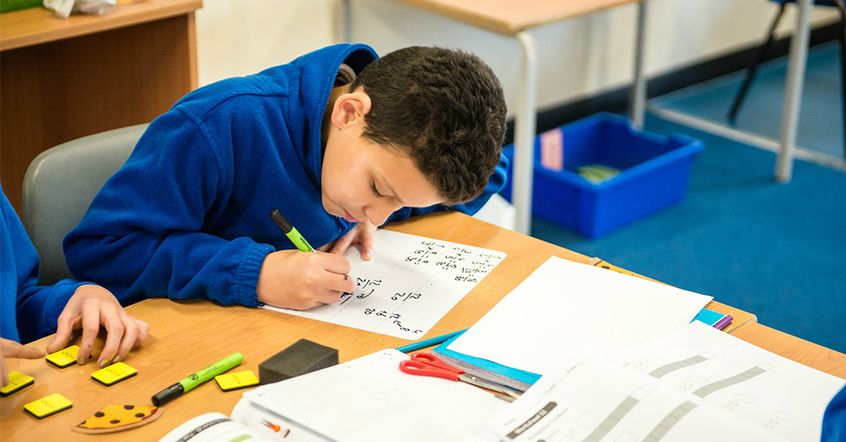Getting The Most Out Of Resources In Year 1
The ability to use a variety of different methods to solve a problem is fundamental in Singapore maths. This skill can be developed using concrete, tangible resources (manipulatives).
There has been much research on why this methodology works but there is less information readily available on how to practically implement using resources in the classroom.
A Year 1 teacher asking 30 pupils to quickly and independently get themselves a whiteboard, whiteboard pen, number line, ten frame and any other resources they think might need to help them solve a problem, is a little like trying to sprint down Oxford Street during Black Friday Sales – impossible!
What we needed in our classroom was a way to store all the resources the children needed in one place; making them accessible and easy to keep tidy and look after. The outcome was the birth of the ‘Maths Pack’.
Large, plastic wallets
Our Year 1 Maths Packs are an organic concept; they grow as the children learn new skills and develop a wider range of strategies to solve problems. The packs are large plastic wallets and initially contain a whiteboard, whiteboard pen, number line and a part-part-whole diagram. As the class progresses through the chapters we add new resources to help the children. For example, when we started the chapter on addition we added a ‘plus’ and ‘equals’ symbol to help them make number sentences, as we noticed some of them were writing a ‘plus’ sign as a multiplication symbol. Having the resource to hand meant those who were writing it incorrectly could use it as a reference until they were confidently writing the symbol correctly.
The resources encourage all children to be problem solvers; it gives them a starting point. If they can see a ten frame in their maths pack, it encourages them to think of applying it to the problem before them: ‘I can see a ten frame; can I use it to solve the problem?’
Using resources as a prompt is important for Year 1 pupils because they do not have an established memory-bank of strategies to draw from to help them with the task. During each lesson, we encourage pupils to use items from their Maths Pack as needed to help them solve a problem. Having a range of resources easily accessible supports them to use various strategies.
Taking ownership of the curriculum
We have observed that as pupils take greater ownership of their progress in maths, they begin to make more purposeful choices about the resources they use. Initially many pupils used the ‘plus’ and ‘equals’ symbols to help them write number sentences, but as they became more familiar with the concept they stopped needing that resource for that purpose; that doesn’t mean, however, that it won’t serve a different purpose in another task. These resource packs enable pupils to become creative learners in maths as they begin to gain an understanding of the efficiency of methodology.
Learning to share
We use one pack per pair of pupils. While this may seem like we are setting ourselves up for endless amounts of snatching and ‘telling tales’, it is in fact deliberate and serves a purpose. By having one pack between two pupils, the pairs are encouraged to naturally engage in a dialogue about how to solve the problem. Ideally the pupils will work together to find the answer, each pupil benefitting from the collaborative process in a different way. The pupil who may be stronger mathematically will gain a deeper understanding by explaining to their partner what they are doing to find the answer and the struggling learner will see good maths practice being modelled.
This method will also work in a group where all learners are ‘struggling’, as collaborating to solve a problem using concrete resources will strengthen their problem-solving skills. Having to share the resources will mean that each child in the pair will attempt to find the answer using a different strategy. This will naturally expose the children to more than one method and generate a dialogue.
Maintaining pace
The Maths Packs also play a vital role for the teacher during lessons. We have found they help the teacher maintain the pace of the lesson as the flow is not continuously being interrupted by handing out resources. Pace plays an integral role in children maintaining engagement throughout the lesson.
As teachers using Maths — No Problem! we know using resources is an essential part of successfully developing a secure sense of number. If our children were not fully equipped with all the resources available to help them solve a problem, it would be much like building a brick house without the mortar; it might look complete but it wouldn’t be secure in the long run. Maths Packs go some way to resolving this dilemma.
Alex Laurie and Emily Downing are editors of the Maths — No Problem! Blog.
Published on May 24, 2017
